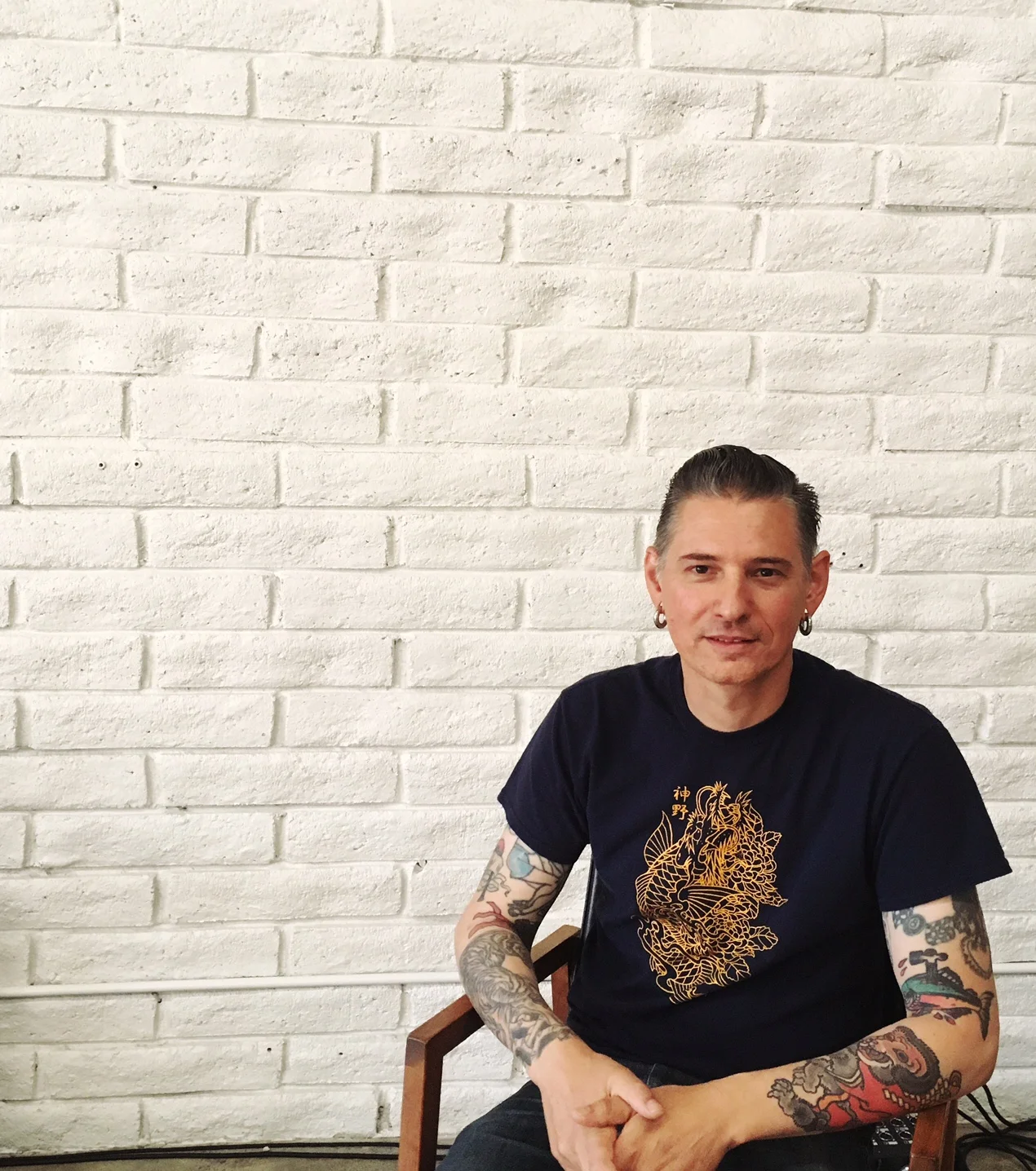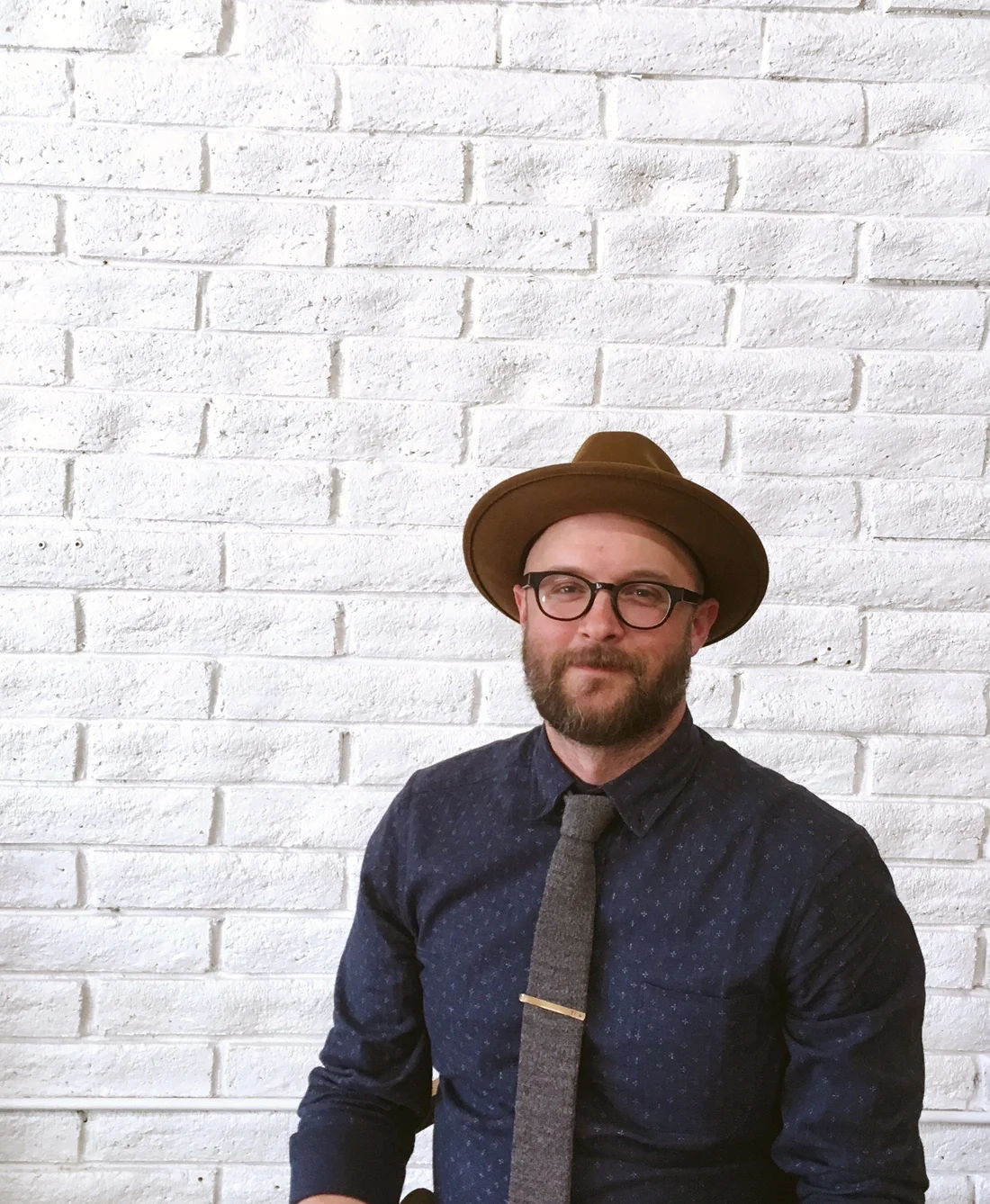Artist Highlight: Martin D.C.
Martin is from Argentina, he has lived in Los Angeles, Kansas, and now Castro Valley. Martin is a tattoo artist and painter. Martin started tattooing in 1991. During that time he was also studying graphic design and working in the bicycle industry. He became more immersed in tattooing when he lived in Los Angeles, during that time he tattooed in the Americana style of nautical tattoos, eagles, and pin-up girls and so on. Eventually, he found the Japanese style of tattooing, “I discovered it by accident I had a friend asking me to fix a Japanese piece he had and it was really old and the artist wasn’t around anymore.” Martin told his friend he was not familiar with the style, but this opportunity motivated him to study Japanese culture, art history, and the language to learn as much as he could about the Japanese style. Martin likes that in the Japanese style of tattooing the entire body is seen as one piece, he finds the freedom to create large pieces fascinating. Martin enjoys Japanese tattoos because, “they stand the test of time.” Martin moved to Castro Valley a year ago come September. He describes tattooing as, “a learning journey . . . you’re always evolving,” he enjoys being in such close proximity to artists in San Francisco. Many artists are accessible and willing to network in the Bay Area, “if you’re a professional you learn from a simple conversation . . . I say the whole Bay Area has a tradition of tattooing.” Martin’s art has been influenced by place, in Los Angeles he was inundated with requests for portraits, praying hands, and Jesus Christ tattoos. With numerous requests for script writing in LA, Martin learned as much as he could from the Latino tattoo artists, some as young as fourteen years old. Martin has noticed the diversity of people who love the Japanese style, he commented, “You can see people from Silicon Valley who go back and forth to Japan because of their jobs and you can see them with suit and tie and you don’t know the guy have whole body style of Japanese tattoo or Americana.” Martin is excited that the acceptance of tattoos has allowed his clients to feel more comfortable with using more of their bodies as a canvas and allowing a liberal use of colors.
Artist Highlight: Cathy, portrait of a mother finding her footing as an artist
“The place is a bit of a mess, and I’m really embarrassed,” Cathy says behind her bangs that curve perfectly over her forehead. I notice blush on her cheeks as her 3rd born smiles at me from across the room in the background of his two older brothers who are leaning on their elbows, their bodies pooling over the kitchen table, engrossed in a cartoon show. Her 11 month old, who took his first steps earlier in the day, is asleep and dreaming in the back bedroom. Her husband, Paul, is here too.
We sit down to homemade pizza and I ask Cathy about how she discovered her art. She confides that she is still figuring her creativity out amidst four young boys and spending 10 years placing herself in the shadow of her husband. She says this in a matter of fact way and with undeniable accountability, like someone who is slowly realizing their own potential. She has been working through, “the idea that you can be a mum in today’s society and care deeply about your children and be completely devoted to them but then also to carve out time to be creative and to care about the things outside of your family that means a lot to you and that being okay.”
She discusses the “mothering circles” and guilt that comes along with the perception of if you are not one hundred percent “in the mummy world,” then you don’t love your children, if you don’t feel that being a mother completes you fully. When Cathy dropped her eldest off at class, she had to complete a form, under occupation, she wrote down artist, a small but deliberate step away from being defined by her past as just a stay at home mom. Like many budding (and established) artists, Cathy has had a hard time owning her creativity and referring to herself as an artist. She has reminded herself on more than one occasion that she does have something to offer people even if it isn’t as good as she would like it to be.
She says that her children have influenced her art and helped her make realizations of how she views herself in relation to art. When Louis and Elliot were younger they would create things, she would complement their art, “and hide it in a drawer because, in a very embarrassing way, it didn’t feel nice enough to hang up in the house.” She admits that she has walked a long way to realize that, “things don’t have to look perfect to be valuable. That we’re all a work in progress.”
Cathy is an accomplished baker, specializing in wedding cakes and celebration cakes. Early August, she made a four tier cheesecake complete with white roses trickling down the side as lush strawberries and blackberries sat atop the surface layers. While she enjoys baking for special occasions, she is struck by, “how short-lived it is.” She explains her desire to create something with more permanence, “It’s so much work and it’s over so quickly, and so I’m trying to explore ways for me to be able to take the things I love without creating cakes. The side I love is feeding people and moving that to feeding people in a way that sustains them and then taking the artistic creative side and trying to find other mediums that allow what I’ve created to be preserved for a bit longer.” Cathy is intrigued by her quest to find a way to create art that lasts beyond a day. She has recently begun dabbling in watercolor paintings. Finding time away to create has brought insight into the creative process as well. While she would like to work at night she is often run ragged from a busy day nurturing and loving on four boys and a creative husband. She gets in where she can fit in, “This morning I was painting with Theo on my back pulling my hair,” she says with a laugh, “but I have to try.” Cathy is gradually becoming more empowered and having to consistently reassure herself that she is worth the time and act of creating.
While reflecting on the delicacy of motherhood and creativity Cathy mentions something Paul often says to illustrate motherhood. With their toddler Nathan in his lap, Paul says that motherhood is, “Like pearls on a string, with no knot on the end,” Cathy laughs and adds, “It’s deeply valuable but those pearls just fall to the ground and get trampled on within minutes. . .seconds.”
Cathy met Paul when she was 17, she was married by 20, and in the United States with their first born baby boy Louis by 22. While reflecting on the past ten years, she says, “I always knew I wanted to be a mother, I don’t think I expected it would happen as early as it did and I don’t think I understood how deeply it would transform my life.” She is currently at a place in her journey where she is trying to find pieces of herself amidst the chaos of motherhood. She acknowledges how fleeting her current season of life is, “But I also don’t want my boys to go away from my home and realize I don’t know myself and I don’t know my husband because I haven’t invested in things that make me come alive.”
The first time Cathy found she could create was when she stepped into the opportunity out of necessity. Her mother burned both of her arms badly while mid-way through creating an anniversary cake, “there was nothing to do then for me to kind of step in, and I didn’t really know what I was doing but she sat with me with her arms bandaged. . .and I realized I was capable of more than I have myself credit for.”
Cathy was born in a small town in West England, her family moved to Brussels when she was eight, where she lived until age 18. She grew up with two siblings who are both in artistic trades. She credits her artistic impulses to her childhood and being raised without television, “We didn’t have anything else to occupy our time other than my mum providing art supplies for us and that was how we passed our time. So I am definitely grateful to her for doing that because I don’t remember a time when I wasn’t creating something.” That creative nurturing has rippled over into how she raises her children, she spends time creating with her boys, “we just enjoy building spaceships out of cardboard boxes-we’ve built kid stools and bird feeders.”
Cathy loves creating meaning through her art and getting away from technology through tasks that allow her to use her hands. In the middle of our conversation about art in the area, Cathy’s third born bounces out of the back bedroom and tells his mother, “There’s a big spider in my bedroom,” he says it two more times so she knows; Cathy kisses his head and advises, “Go shoo him away.” She returns to our conversation and acknowledges her desire to spend more time in the adult art world, “I’m aware that I need to spend more time going to galleries and going to classes for myself, but what I’ve been involved in is looking at stuff for my kids to be a part of.” One set back she has identified to nourishing the teaching of art is the high prices of workshops and classes. The lack of affordability concerns her in that people of low socioeconomics will have less opportunity to learn and grow as artists. She hopes to see more community oriented art classes, “and for art to be available for all.” She believes the work of Smalltown Society and the opportunities of how to best use “the space” is helping to intervene in the gaps present in art in the community.
As far as her artistic goals, Cathy plans to engage in her art more often. She is currently brainstorming ways to provide more opportunities for mothers to get out of the house “get away from housework and babies and have a time and a space to be creative together.”
Artist Highlight: Eric Stevens
Eric, grew up in Alabama, lived in Chicago a bit, and found his way out to the Bay Area in 2004, through, “a series of experiments for the most part.” He attended Auburn College and studied industrial design which would later inspire him to pursue furniture work. Eventually, Eric worked for a furniture design firm but “got a little bit burned out.” He left the firm and decided to open his own shop so he could better understand what it meant to design things for other people. Eric found his design style through what was lacking when he looked at carpentry and wood working magazines. He felt inspired after reading about an artist who used mechanisms to carve wood. Although he didn’t implement the techniques immediately, it laid the foundation for experimentation with his creative medium 5 years later. He credits creative experimentation as the catalyst for making a return to furniture and create a cohesive body of work again. Eric reflected on making 100 pieces in 100 days, “So each piece was made in basically a day sometimes it would lapse over to finishing but my goal was to photograph each piece and publish it.” He commented that the biggest hurdle in accomplishing his goal was persistence and it took constantly “showing up,” for his art amidst all the things happening in life to pull him away from his art. He found immense focus through the experimental 100 pieces and worked with intention to, “try to do a better job each time.” He trashed approximately 40 of the pieces. He said there are times when he wants to trash everything he makes and commented that his work is subjective in the eyes of other people. He accepts that people either like or dislike his work while acknowledging that he has not pushed himself to sell his pieces. Since he has not moved many pieces, Eric is often surrounded by his art, which he compares to, “staring at yourself in the mirror.” Each piece Eric makes takes time. The cost of metal plates and studio space and the lumber all adds up and is factored into how he feels about his work. Eric’s shift from Oakland to the Eden area has been gradual; he has been in the area for a year and a half and is slowly meeting new people. The Oakland area is full or artists flowing from San Francisco, he commented on the way artists and creativity in Oakland feeds off of one another. Eric is slowly immersing himself in the community and making connections, most recently at the Castro Valley lumber yard, “this gem in the middle of nowhere, kind of hidden and that was fantastic, they have wood that’s been drying in the air for about 40 years and just giant pieces of redwood.” Eric identified that space is a commodity in the area and is much needed in order to get artists creating and gathering in a community setting.
Artist Highlight: Talin Wadsworth
Talin has been a print artist for 15 years now; he discovered his art while he was studying to be an architect. During a design class, he was tasked with making a CD cover, “and from then on all I wanted to do was make rock and roll posters . . . I just wanted to make cool stuff for bands in the community.” Afterwards, Talin became immersed in printing, silk screening, letterpress, “and I just got really into the craft and process of printing.” A few years ago, Talin found his new mode of printing when a friend turned him on to the risograph, “it’s this really kind of old school like printer that prints one color at a time . . .I just knew it was a thing that I had to have.” Talin found the technology to be so revolutionary to his design process that he convinced his boss to purchase a risograph.
Talin enjoys the process of his work, “I just like following the process all the way through and having my hands on every part of that process.” Talin reflected on his varied past of dabbling in one form of printing or another, “and just like making a lot of zines on photocopies in the middle of the night and the risograph just seemed like the culmination of all these kinds of loves.” While much of Talin’s work has been for himself, one of his goals in bringing the risograph into his design studio “is to get other people involved.” He discussed the effect this form of printing has had on a younger generation of designers, “a lot of them had never seen their piece go from a sketch into a full design on the computer or even by hand and then seeing it printed and seeing it handed out and seeing it up and around. We’re just so used to seeing our work on screens.” The addition of this tangible form of printing has helped build community among designers in Talin’s office, they spend time creating together in ways they hadn’t previously, “it has opened up a new way of thinking and working for them.” Talin commented on how digital technology has allowed for more exposure for designers and created more opportunities, “people still love books, people still love putting their hands on a print and love hanging it on their wall or having it on their desk and I think what we’re realizing is that’s never going to go away.” Talin moved to the Eden area in search of a home and a community. Talin hopes that there will be more street level engagement with art in the community within the Eden area. He commented on the dwindling store front spaces that can help people, “just kind of swerve into this new world and . . . jolt them from their day to day and just kind of happen on new experiences.”
https://www.behance.net/talinwadsworth




